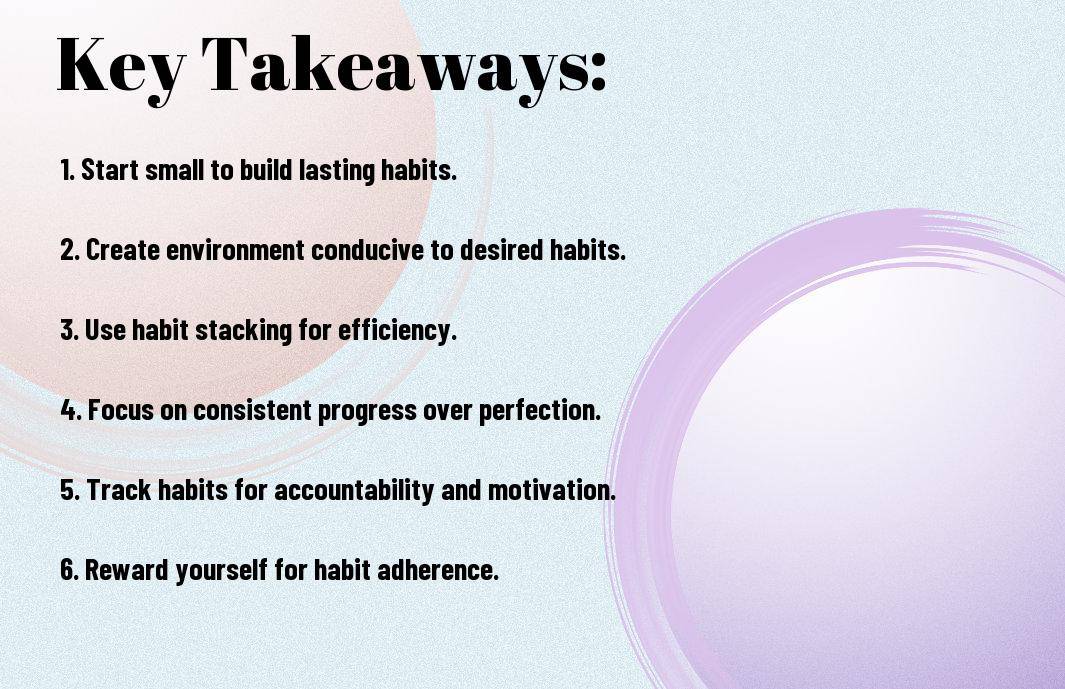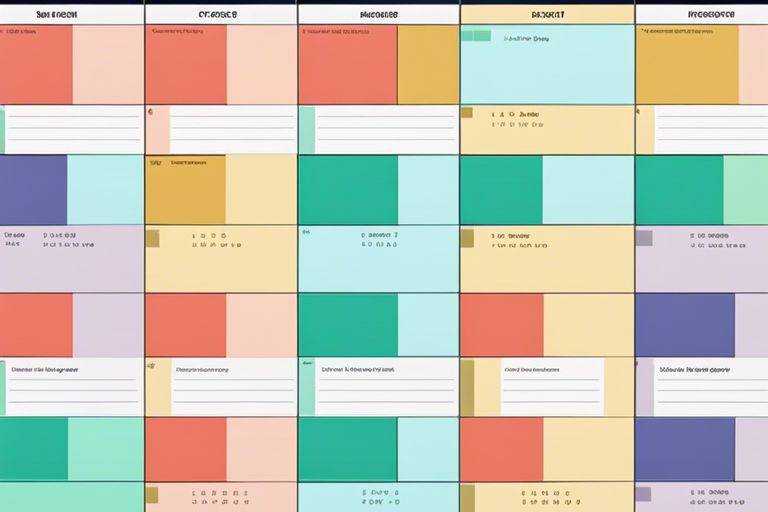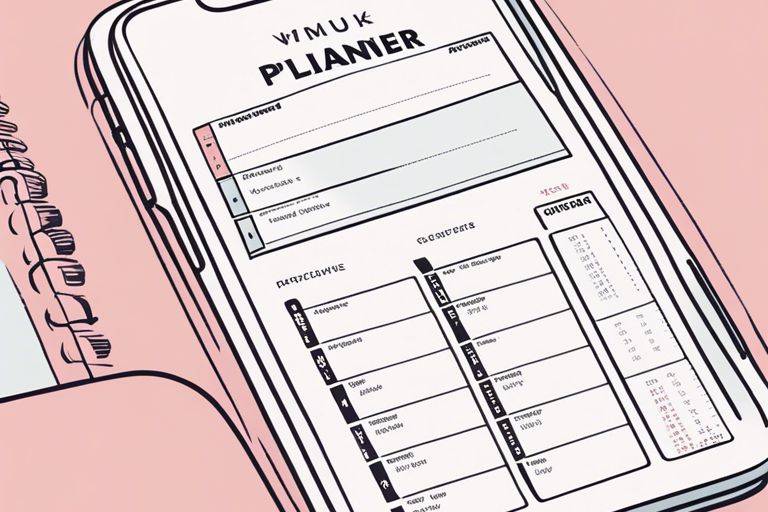Corporate productivity is vital for the success of any business. One powerful tool that can help enhance productivity in the workplace is developing atomic habits. These small, incremental changes advocated by author James Clear can have a significant impact on employee performance and overall organizational success. In this blog post, we will explore how implementing the 4 Laws of Atomic Habits can transform the way businesses operate. For a more in-depth look at this topic, check out The 4 Laws Of Atomic Habits At Work: A Practical Guide – Swag.
Key Takeaways:
- Cultivate the 1% improvement mindset: Focus on making small incremental changes each day to continually improve habits and productivity.
- Make habits obvious, attractive, easy, and satisfying: Use cues, design environment, make tasks appealing, simplify processes, and reward yourself to reinforce positive habits.
- Implement habit stacking: Connect new habits with existing ones to efficiently build routines and increase productivity.
- Employ the two-minute rule: Break down tasks into smaller, manageable parts that can be completed in two minutes to overcome procrastination and initiate productivity.
- Set up an environment for success: Modify your surroundings to support productive habits, remove distractions, and create a workspace that enables focus and efficiency.
- Track habits and measure progress: Use habit trackers, goal setting, and data analysis to monitor performance, identify patterns, and make adjustments for continual improvement.
- Focus on identity-based habits: Align your habits with the person you want to become, shaping your identity to drive motivation and consistency in productivity enhancement.


Laying the Foundations: Core Concepts of Atomic Habits for Corporations
Defining Atomic Habits and Their Importance in the Workplace
Even the smallest habits can have a significant impact on our daily productivity in the workplace. Atomic habits are the tiny changes and routines that compound over time, leading to remarkable results. In corporate settings, these habits play a crucial role in shaping employee performance, overall team productivity, and organizational success.
The Four Laws of Behavior Change for Corporate Success
Any organization looking to enhance productivity and efficiency must understand the Four Laws of Behavior Change: Cue, Craving, Response, and Reward. These laws, as outlined by James Clear in his book “Atomic Habits,” provide a roadmap for creating and sustaining positive habits in the workplace. By mastering these laws, companies can drive behavior change, foster a culture of continuous improvement, and optimize performance.
Atomic habits, rooted in the concept of making small changes that lead to big results, are the foundation of sustainable productivity improvements in corporate environments. By implementing strategies based on the Four Laws of Behavior Change, organizations can empower employees to adopt new habits, break old patterns, and drive lasting organizational success.
Foundations are laid by understanding the core concepts of Atomic Habits and the Four Laws of Behavior Change. These principles serve as the building blocks for creating a productive and efficient workplace culture. It is crucial to grasp the significance of these concepts to drive meaningful behavior change and achieve long-term success in corporate settings.
The Building Blocks of Productive Habits
After setting the goal for improving productivity in a corporate environment, the next step is to understand the building blocks of productive habits. These habits can be instrumental in enhancing efficiency, boosting morale, and achieving success in the professional realm.
How to Identify High-Impact Habits in Your Professional Life
Habits are the small actions and routines that we do consistently every day. To identify high-impact habits in your professional life, start by analyzing your current daily routine. Look for patterns that either contribute to or hinder your productivity. Focus on habits that have a direct impact on your work performance and overall well-being. These could include habits related to time management, communication, organization, or self-care.
Strategies for Habit Stacking in a Busy Corporate Environment
The concept of habit stacking involves linking a new habit with an existing one to ensure it becomes part of your routine. In a busy corporate environment, where time is limited, habit stacking can be a powerful tool for establishing and maintaining productive habits. By incorporating new habits into your existing daily rituals, you can increase the likelihood of their success and sustainability.
Stacking your habits strategically can lead to significant improvements in your productivity and efficiency at work. Identify key anchor habits that you already perform consistently, such as checking emails in the morning or taking a lunch break at a specific time. Then, intentionally add new habits before, during, or after these anchor habits to create a seamless routine. This approach can help streamline your workflow and make adopting new habits feel more natural and effortless.
Cultivating a High-Performance Corporate Culture
Fostering an Environment That Encourages Habit Development
Not every corporate culture is conducive to habit development, but creating an environment that supports and encourages the growth of positive habits is necessary for enhancing productivity. By establishing routines, providing resources for personal development, and fostering a sense of accountability, organizations can empower their employees to adopt habits that lead to increased efficiency and success.
Leadership’s Role in Promoting Productive Behaviors
One of the key factors in cultivating a high-performance corporate culture is the role that leadership plays in promoting productive behaviors. Leaders have a significant influence on company culture and employee habits, so it is crucial for them to lead by example and consistently demonstrate the behaviors they wish to see in their teams. By setting clear expectations, providing support and guidance, and recognizing and rewarding positive habits, leaders can create a work environment that thrives on productivity and success.
This is why it is important for leaders to prioritize the development of productive habits within their teams. By focusing on creating a positive work environment that supports habit formation, leaders can help drive employee engagement, motivation, and ultimately, the success of the organization.
Overcoming Common Challenges to Habit Formation
Tackling Procrastination Head-On
Challenges are a natural part of habit formation, and one common obstacle that many individuals face is procrastination. Unlike other challenges, procrastination can be particularly insidious, as it can derail even the best-laid plans for developing new habits. To tackle procrastination head-on, it’s necessary to understand the root of the behavior. Procrastination often stems from a fear of failure, perfectionism, or simply feeling overwhelmed by the task at hand.
Addressing Lack of Motivation Among Teams
Overcoming a lack of motivation among teams can present a significant hurdle in establishing productive habits in a corporate setting. Challenges such as team members feeling disengaged, uninspired, or lacking a sense of purpose can hinder the adoption of new habits that promote productivity. Addressing this hurdle requires effective leadership and a focus on building a culture that fosters enthusiasm, collaboration, and a shared vision. By creating a supportive environment and setting clear goals, team members can feel empowered and motivated to embrace new habits that drive success.
Habit: Addressing lack of motivation among teams is crucial for creating a productive and engaged workforce. By fostering a culture of motivation and empowerment, teams can overcome obstacles and achieve their full potential.
Advanced Techniques for Sustaining Productivity
Once again, to enhance productivity in corporate settings, it’s crucial to implement advanced techniques that can help sustain and improve performance over time. Two key strategies for achieving this are tracking progress and maintaining accountability within teams, as well as leveraging feedback and continuous improvement processes.
- Tracking Progress and Maintaining Accountability in Teams
Strategy Description Regular Check-Ins Conduct periodic meetings to assess progress and address any challenges. Goal Setting Establish clear objectives for each team member and track their achievements.
The Role of Feedback and Continuous Improvement
Productivity is not just about individual performance but also about how well a team can work together towards a common goal. By regularly providing feedback to team members and encouraging a culture of continuous improvement, organizations can optimize their productivity levels and achieve greater success.
Teams that embrace feedback as a tool for growth and view continuous improvement as a shared responsibility tend to outperform their peers. This proactive approach not only enhances individual skills but also fosters a sense of collaboration and collective achievement within the team.
Integrating Technological Tools and Atomic Habits
Leveraging Software and Apps to Build Better Workplace Habits
Habits are the foundation of our daily routines, and integrating technological tools into our workflow can greatly enhance productivity. Software and apps designed for time management, task tracking, and goal setting can help us streamline processes and stay on track with our goals. By incorporating these tools into our daily routine, we can build better workplace habits that lead to increased efficiency and overall performance.
The Interplay between Digital Distractions and Productive Routines
Digital distractions are a common challenge in today’s fast-paced work environment. The constant notifications, emails, and social media alerts can disrupt our focus and hinder our productivity. It’s important to recognize the interplay between these distractions and our productive routines. By implementing strategies to minimize distractions and create boundaries around technology use, we can optimize our work habits and achieve better results.
Routines
Creating a structured routine that includes designated times for focused work, breaks, and digital detox can help combat the negative effects of digital distractions. By establishing consistent daily habits and sticking to them, we can improve our productivity and well-being in the corporate setting. Keep in mind, small changes in our routines can lead to big improvements in our work performance.
Employee Well-Being and Its Connection to Productivity
To foster a productive work environment, it is crucial for companies to prioritize the well-being of their employees. Employee well-being is not only crucial for individual happiness but also directly impacts overall productivity levels in corporate settings. When employees feel their well-being is valued, they are more likely to be engaged, motivated, and efficient in their work.
Balancing Workloads with Habit-Builded Rest and Recovery
Well-being is about more than just physical health; it encompasses mental and emotional wellness as well. One key aspect of well-being is finding a balance between work responsibilities and rest and recovery. By incorporating habits that promote rest and recovery, such as taking regular breaks, practicing mindfulness, or setting boundaries between work and personal life, employees can improve their overall well-being and ultimately enhance their productivity.
Encouraging Healthy Work Habits for Long-Term Benefits
With the long-term well-being of employees in mind, it is important for organizations to encourage healthy work habits. This includes promoting regular exercise, providing healthy snack options, offering mental health resources, and creating a supportive work environment. By investing in the health and well-being of employees, companies can experience positive returns such as reduced absenteeism, increased loyalty, and higher productivity levels.
Summing up
So, incorporating atomic habits into corporate settings can significantly enhance productivity. By focusing on small, everyday changes, individuals can create a more efficient work environment. For more insights on how these habits can benefit your productivity, check out 4 Atomic Habits That Can Increase Your Productivity – Calendar.
FAQ
Q: Why is it important to develop atomic habits for productivity enhancement in corporate settings?
A: Developing atomic habits can lead to consistent improvements in productivity, which is crucial in corporate settings where efficiency and effectiveness are key to success.
Q: What are atomic habits?
A: Atomic habits are small, incremental changes or routines that when practiced consistently, can lead to significant improvements over time.
Q: How can atomic habits help in enhancing productivity at work?
A: By focusing on small, manageable changes, atomic habits make it easier to build momentum and sustain progress, ultimately leading to increased productivity in the workplace.
Q: How can one start developing atomic habits for productivity in a corporate environment?
A: To start developing atomic habits for productivity enhancement in corporate settings, it’s important to identify specific areas for improvement, set clear goals, and start with small, achievable changes.
Q: What are some examples of atomic habits that can boost productivity in a corporate setting?
A: Examples of atomic habits for productivity enhancement in corporate settings include time blocking for focused work, setting daily priorities, taking short breaks to recharge, and practicing gratitude to maintain a positive mindset.
Q: How long does it typically take to see results from implementing atomic habits for productivity enhancement?
A: Results from implementing atomic habits may vary for each individual, but consistency is key. It may take a few weeks to a few months to see noticeable improvements in productivity in a corporate setting.
Q: What are some common challenges one might face when trying to develop atomic habits for productivity in a corporate environment?
A: Common challenges when developing atomic habits for productivity in a corporate setting include resistance to change, lack of accountability, distractions, and reverting to old habits. Overcoming these challenges requires persistence, self-awareness, and a supportive environment.



